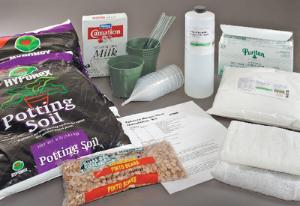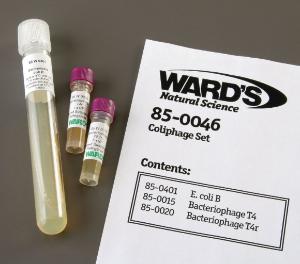Spreading the facts about viruses
Middle and High School
Careful, this post could go viral!
There are 219 virus species that are known to be able to infect humans. The first one discovered was the yellow fever virus in 1901 by Walter Reed. Three to four new species are still being found every year, that's nothing to sneeze at! 1
What are viruses?
Most scientists have concluded that viruses are not living but a complex collection of organic matter that can self-replicate. They mostly consist of a shell made of protein, which inside contains either DNA or RNA with enzymes for replication and manipulation of their genetic materials.
Viruses are everywhere in our environment. From the food we eat to the air we breathe, we take in millions of viruses every second (sounds scary, but it's normal). Some viruses can kill bacteria, while others can fight against other, more dangerous viruses. So, like protective bacteria (probiotics), we have several viruses in our bodies that don't cause disease. In fact, viral infections at a young age are an important part of building a strong immune system.
Unfortunately, many viruses cause a lot of harm to their hosts, ranging from the common cold to serious conditions like severe acute respiratory syndrome (SARS).
What are the key characteristics of viruses?
- They don't have an organized cell structure
- They have no cell nucleus
- They don't metabolize food into energy
- They typically have one or two strands of DNA or RNA
- They are covered with a protective coat of protein called the Capsid
- They are inactive when not inside a living cell, but are active when inside another living cell
- They can't reproduce without the aid of a host
- They are tinier than cells (you need an electron microscope to see them)
Interesting facts to know about viruses
- Most scientists don't classify viruses as living things. This means they are not bacteria, fungi, protists, plants, or animals. Can someone say, "Identity crisis!"
- You can't classify a virus as a prokaryote or a eukaryote; it's not a cell.
- The word "virus" comes from the Latin word "virulentus" meaning "poisonous."
- A virus that contains RNA instead of DNA is sometimes called a retrovirus. Retro…groovy!
- Viruses are very specific or picky about the types of cells that they go after (i.e., HIV goes after immune cells, making us very vulnerable to infections).
How do viruses take over cells?
A virus must infect some kind of cell. Cells manufacture proteins, replicate DNA and store resources. This makes them the perfect hosts for viruses. Some hosts are tricked into recognizing the virus as a food particle, yech!
Viruses take over the cells of living organisms by injecting them with their genetic material. They then use the cell to make more viruses and take over more cells. They turn healthy cells into virus-producing zombies!
The virus uses its Capsid covered in small molecular receptors to bind and join to the membrane of a cell; that's the part that determines which cells a virus can infect. Once that virus attaches to a cell, it injects either its DNA or RNA, depending on what kind of genetic material it has. The cell takes that genetic material and starts following the instructions. The virus-factory is complete!
Why are viruses so dangerous?
When viruses invade a body's cells and begin to multiply, they make the host sick. Viruses cause a lot of diseases.
The cell uses its own resources to build copies. It becomes an unwitting pawn in the virus's sick game… the lytic phase. The cell makes so many copies of the virus that it can cause the cell membrane to rupture, explode, lyse! Even worse, now these new viral copies get out of the cell, and they infect other cells and repeat the process.
Some viruses may remain dormant inside host cells for long periods, causing no obvious change in their host cells. That's a sneaky little bugger! So, when the host cell replicates, it also unknowingly replicates the virus's DNA material…the lysogenic phase. Then when this dormant virus is triggered (by stress, chemicals, U.V. radiation, or other stimuli), it also enters the destructive lytic phase.
Examples of viruses
There are many viruses that can infect people and make them sick. One of the most common is influenza, which causes people to get the flu. Other diseases caused by viruses include smallpox, the common cold, chickenpox, shingles, herpes, polio, rabies, Ebola, hanta fever, and AIDS.
Today we have the novel (new) coronavirus disease (COVID-19). Coronaviruses are a large family of viruses that are common in people and many different species of animals, including camels, cattle, cats, and bats. Two well-known strains are called SARS (Severe Acute Respiratory Syndrome) and MERS (Middle East Respiratory Syndrome). COVID-19 is a newly discovered strain of the coronavirus. Viruses are continuously changing as a result of genetic selection. They undergo subtle genetic changes through mutation and major genetic changes through recombination. Mutation occurs when an error is incorporated in the viral genome. Recombination occurs when coinfecting viruses exchange genetic information, creating a novel virus.2
How do viruses spread?
Viruses are microscopic and lightweight. They can float through the air, survive in water, or even on the surface of your skin. Viruses can be passed from one person to another by shaking hands, touching food, sharing drinks, or through the air when a person coughs or sneezes. That's why covering your mouth with a tissue or your elbow when you cough or sneeze and handwashing are such powerful ways to help protect us all from getting sick!
Viruses can also be passed on by insect bites, animals, or through bad food.
Zoonosis is the term used to describe a virus that spreads from non-human animals to humans. You've probably heard of bird flu and swine flu; they are zoonoses. While a lot of viruses can cross species, only around half of these can be transmitted by humans, and only half of those can transmit well enough to cause an outbreak.
How are viruses treated?
Medications like antibiotics are used to kill bacteria like E. coli, which are living things. But if you have a cold or other viral infection, you can treat the symptoms, but there is little that doctors can do to treat the actual virus. In most cases, our body's immune system fights off the infection. Scientists have developed vaccines that help our bodies to build up immunity to a specific virus. One example of a vaccine is the flu shot. The flu shot helps the body to develop its own defenses against the flu called antibodies.
The curious minds in your classroom will have a lot to chew on when they investigate the complex world of viruses. There are good viruses and bad ones; scientists are researching the virus's role in gene therapy and pest control, for example. The good news is that it's not all bad news.
P.S. this viral message is safe to spread.
- U.S. National Library of Medicine - National Institutes of Health. Human viruses: discovery and emergence (2012)
- Medical Microbiology - 4th edition. Chapter 43, Viral Genetics W. Robert Fleischmann, Jr.
Recommended products
[StartProductBlock]

Ward's® Tobacco Mosaic Virus Inoculation Lab Activity
Study the effects of viral transmission. Explore viral damage to living plant organisms. Discuss applications for viral-induced genetic engineering.
[EndProductBlock]
[StartProductBlock]

Ward's® Coliphage Culture and Titer Determination Lab Activity
Introduce students to the lytic mode of a bacteriophage life cycle. Or you can use the serial dilution technique to explore the concept of bacteriophage titer.
[EndProductBlock]
[StartProductBlock]

Ward's® Live Coliphage Set
Practice techniques used in genetics and biotechnology studies. The set introduces students to handling techniques of virulent microbial viruses.
[EndProductBlock]
